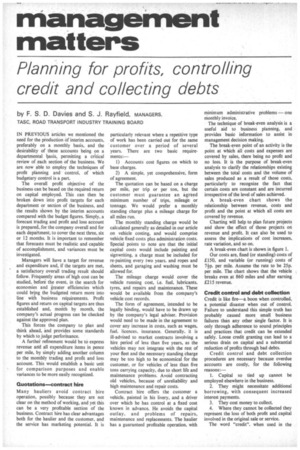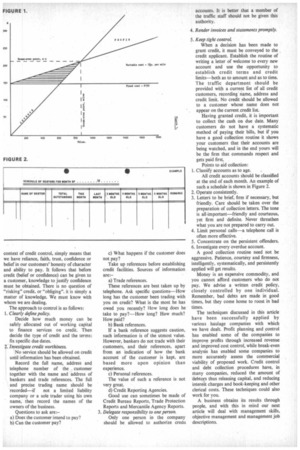ririanagetnent matters
Page 46

Page 47

If you've noticed an error in this article please click here to report it so we can fix it.
Planning for profits, controlling credit and collecting debts
by F. S. D. Davies and S. J. Rayfieid, MANAGERS. TASC, ROAD TRANSPORT INDUSTRY TRAINING BOARD
IN PREVIOUS articles we mentioned the need for the production of interim accounts, preferably on a monthly basis, and the desirability of these accounts being on a departmental tosis, permitting a critical review of each section of the business. We are now able to employ the techniques of profit planning and• control, of which budgetary control is a part.
The overall profit objective of the business can be based on the required return on capital employed. This can then be broken down into profit targets for each department or section of the business, and the results shown by the interim accounts compared with the budget figures. Simply, a forecast trading and profit and loss account is prepared, for the company overall and for each department; to cover the next three, six or 12 months. It is important to remember that forecasts must be realistic and capable of accomplishment, and variances must be investigated.
Managers will have a target for revenue and expenditure and, if the targets are met, a satisfactory overall trading result should follow. Frequently areas or high cost can be studied, before the event, in the search for economies and greater efficiencies which could bring the budgeted return more into line with business requirements. Profit figures and return on capital targets are thus established and, month by month, the company's actual progress can be checked against the approved plan.
This forces the company to plan and think ahead, and provides some standards by which to judge perforinance.
A furthei refinement would be to express revenue and all expenditure items in pence per mile, by simply adding another column to the monthly trading and profit and loss account. This would establish a basic unit for comparison purposes and enable variances to be more easily recognized.
Quotations—contract hire
Many hauliers avoid contract hire operation, possibly because they are not clear on the method of working, and yet this can be a very profitable section of the business. Contract hire has clear advantages both for the haulier and the customer, and the service has marketing potential. It is particularly relevant where a repetitive type of work has been carried out for the same customer over a period of several years. There are two basic requirements 1) Accounts cost figures on which to base charges.
2) A simple, yet comprehensive, form of agreement.
The quotation can be based on a charge per mile, per trip or per ton, but the customer must guarantee an agreed minimum number of trips, mileage or tonnage. We would prefer a monthly standing charge plus a mileage charge for all miles run.
The monthly standing charge would be calculated generally as detailed in our article on vehicle costing, and would comprise vehicle fixed costs plus administration costs. Special points to note are that the initial capital costs would include painting and signwriting, a charge must be included for re-painting every two years. and ropes and sheets, and garaging and washing must be allowed for.
The mileage charge would cover the vehicle running cost, i.e. fuel, lubricants, tyres, and repairs and maintenance. These would be available from the company's vehicle cost records.
The form of agreement, intended to be legally binding, would have to be drawn up by the company's legal adviser. Provision would need to be made in the agreement to cover any increase in costs, such as wages, fuel, licences. insurance. Generally. it is ill-advised to market contracts involving a hire period of less than five years, as the vehicles may not integrate with the rest of your fleet and the necessary standing charge may be too high to be economical for the customer, or for vehicles of less than five tons carrying capacity, due to short life and maintenance problems. Avoid contracting old vehicles, because of unreliability and high maintenance and repair costs.
Contract hire offers the customer a vehicle, painted in his livery, and a driver over which he has control at a fixed cost known in advance. He avoids the capital outlay, and problems of repairs, maintenance and replacements. The haulier has a guaranteed profitable operation, with minimum administrative problems — one monthly invoice.
The technique of break-even analysis is a useful aid to business planning, and provides basic information to assist in management decision making.
The break-even point of an activity is the point at which all costs and expenses are covered by sales, there being no profit and no loss. It is the purpose of break-even analysis to clarify the relationships existing between the total costs and the volume of sales produced as a result of those costs, particularly to recognize the fact that certain costs are constant and are incurred irrespective of the level of sales achieved.
A break-even chart shows the relationship between revenue, costs and profit and the point at which all costs are covered by revenue.
Charting will help to plan future projects and show the effect of those projects on revenue and profit. It can also be used to assess the implications of cost increases, rate variation, and so on.
A break-even chart is shown in figure 1.
Our costs are, fixed (or standing) costs of £150, and variable (or running) costs of Tfp. per mile. Assume the rate to be 25p. per mile. The chart shows that the vehicle breaks even at 860 miles and after earning £215 revenue.
Credit control and debt collection
Credit is like fire—a boon when controlled, a potential disaster when out of control. Failure to understand this simple truth has probably caused more small business failures than any other single factor. It is only through adherence to sound principles and practices that credit can be extended safely. Loose credit granting can lead to a serious drain on capital and a substantial reduction of profits through bad debts.
Credit control and debt collection procedures are necessary because overdue accounts are costly, for the following reasons:
1. Capital so tied up cannot be employed elsewhere in the business.
2. They might necessitate additional borrowing, with consequent increased interest payments.
3. They cost money to collect.
4. Where they cannot be collected they represent the loss of both profit and eapital involved in the original sale or service.
The word "credit", when used in the context of credit control, simply means that we have reliance, faith, trust, confidence or belief in our customers' honesty of character and ability to pay. It follows that before credit (belief or confidence) can be given to a customer, knowledge to justify confidence must be obtained. There is no question of "risking" credit. or "obliging". it is simply a matter of knowledge. We must know with whom we are dealing.
The approach to control is as follows: 1. Clearly define policy.
Decide how much money can be safely allocated out of working capital to finance services on credit. Then decide the type of credit and the terms: fix specific due dates.
2. Investigate credit worthiness.
No service should be allowed on credit until information has been obtained.
Record the full name, address and telephone number of the customer together with the name and address of bankers and trade references. The full and precise trading name should be recorded—if not a limited liability company or a sole trader using his own name, then record the names of the owners of the business.
Questions to ask are:—
a) Does the customer intend to pay?
b) Can the customer pay? c) What happens if the customer does not pay?
Take up references before establishing credit facilities. Sources of information are:—
a) Trade references.
These references are best taken up by telephone. Ask specific questions—How long has the customer been trading with you on credit? What is the most he has owed you recently? How long does he take to pay?—How long? How much? How paid?
b) Bank references.
If a bank reference suggests caution, such information is of the utmost value. However, bankers do not trade with their customers, and their references, apart from an indication of how the bank account of the customer is kept, are based more upon opinion than experience.
c) Personal references.
The value of such a reference is not very great.
d) Credit Reporting Agencies.
Good use can sometimes be made of Credit Bureau Reports, Trade Protection Reports and Mercantile Agency Reports. 3. Delegate responsibility to one person. Only one person in the company should be allowed to authorize credit. accounts. It is better that a member of the traffic staff should not be given this authority.
4. Render invoices and statements promptly.
5. Keep tight contra When a decision has been made to grant credit, it must be conveyed to the , credit applicant. Establish the routine of writing a letter of welcome to every new account and use the opportunity to establish credit terms and credit limits—both as to amount and as to time. The traffic department should be provided with a current list of all credit customers, recording name, address and credit limit. No credit should be allowed to a customer whose name does not appear on the current credit list.
Having granted credit, it is important to collect the cash on due date. Many customers do not have a systematic method of paying their bills, but if you have a good collection routine it shows your customers that their accounts are being watched, and in the end yours will be the firm that commands respect and gets paid first.
Points to aid collection: I. Classify accounts as to age.
All credit accounts should be classified at the end of each month. An example of such a schedule is shown in Figure 2.
2. Operate consistently.
3. Letters to be brief, firm if necessary, but friendly. Care should be taken over the preparation of collection letters. The tone is all-important—friendly and courteous, yet firm and definite. Never threathen what you are not prepared to carry out.
4. Limit personal calls—a telephone call is often more effective.
5. Concentrate on the persistent offenders.
6. Investigate every overdue account.
A good collection routine need not be aggressive. Patience, courtesy and firmness, intelligently, systematically, and persistently applied will get results.
Money is an expensive commodity, and you cannot afford customers who do not pay. We advise a written credit policy, closely controlled by one individual. Remember, bad debts are made in good times, but they come home to roost in bad times.
The techniques discussed in this article have been successfully applied by various haulage companies with which we have dealt. Profit planning and control has enabled some of the companies to improve profits through increased revenue and improved cost control, while break-even analysis has enabled some companies to more accurately assess the commercial viability of proposed work. Credit control and debt collection procedures have, in many companies, reduced the amount of debtors thus releasing capital, and reducing intereit charges and book-keeping and other clerical costs. These techniques could also work for you.
A business obtains its results through people, and with this in mind our next article will deal with management skills, objective management and management job descriptions.




















































































